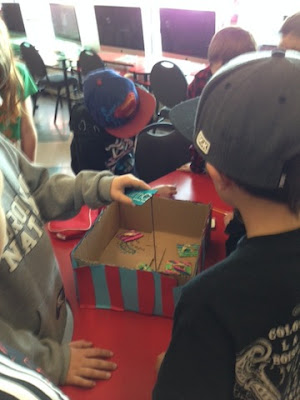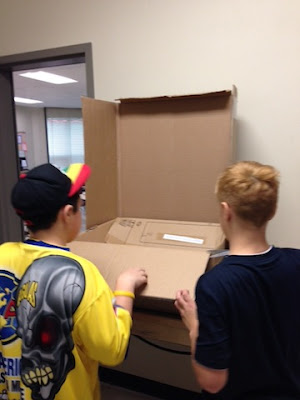Posted by Erin Quinn
I taught an option class to my grade sevens last term called Creative Problem Solving. I decided to focus on games and play - a great move, because my students loved this class so much. It was one of those delightful times when they were learning a lot without really even knowing they were learning.
We started with The Institute of Play's Gamekit. The term's work took them through three projects, all having to do with games.
Warm Up: Find Play in Things
I gave them plastic cups, elastic bands, tokens, paper clips, and yarn, and they had to choose three items and invent a game.
Hack a Board Game
I pilfered my local second hand store for board games and came back with a bunch. They worked in groups, chose one, and had to think of new ways to play. They had to hack the rules, and invent a new game, using the pieces from an existing game.
Caine's Arcade
We watched Caine's Arcade. It was just beautiful how this happened. After it was over, I asked "What did you think?" And the kids shared how awesome it was, and how great Caine's contraptions were, and how fun it looked. And then, innocently, a student asked, "Can we make a cardboard arcade?" Oh glorious day! Such a question! So off we went.
This was the major project of the term, and the one that took the most time. We put an all call out for cardboard, and had a storage room full of it in no time to work with. The students created a wide variety of games, some invented and some borrowed: skee ball, Plinko, coin dozer, basketball, ring toss.
When they finished building their arcade games, and testing them, then we added an element of social innovation to the project. We held our cardboard arcade at lunch one day and invited the school to come and play. Each turn was a quarter, with all proceeds donated to our school's Me to We Club, who is trying to raise $10,000 to build a school in Ghana. And in that process, the students had an authentic audience for their work.
I Never Once Mentioned the Strands
Throughout all three of these activities, the students experienced all seven strands of creative development. They collaborated with each other. They self-instigated their own ideas - they made decisions that were motivating and relevant to them. They investigated ideas and sought inspiration for their ideas from different sources. They generated. Oh did they generate! And they experimented. Prototyping ideas happened a lot. Their planning for their games tended to take this form: try out an idea to see if it will work. I encouraged this; I did not put the pressure on that their games had to be "finished" within a class period, giving them freedom to test ideas and not feel a time crunch if their ideas didn't work. I encouraged them to try new solutions to the problems they had in their game design and creation. Through this process, they analyzed their ideas to find the best one. And they absolutely reached creative sustain. While they were working on their arcade games, they would come to class, drag out their arcade game in progress, and get right to work. They didn't need to ask me what to do, they just did it. This sustained them creatively for weeks.
Although they experienced the seven strands, I didn't stop them to talk about them. I made the decision that they needed to just play, rather than hearing me talk about this. This was an experiement on my part. I wanted to see if they would experience the strands even without knowing what to call them. It worked.
Moral of the Story
Don't stress about how you are going to communicate the creative process to your students. Set them up so they will experience it. If you teach grade 1, are they going to understand what "Creative Sustain" means? Nope. But will they love the feeling when they're immersed in a creative project? Absolutely.










 Erin Quinn
Erin Quinn









Be First to Post Comment !
Post a Comment